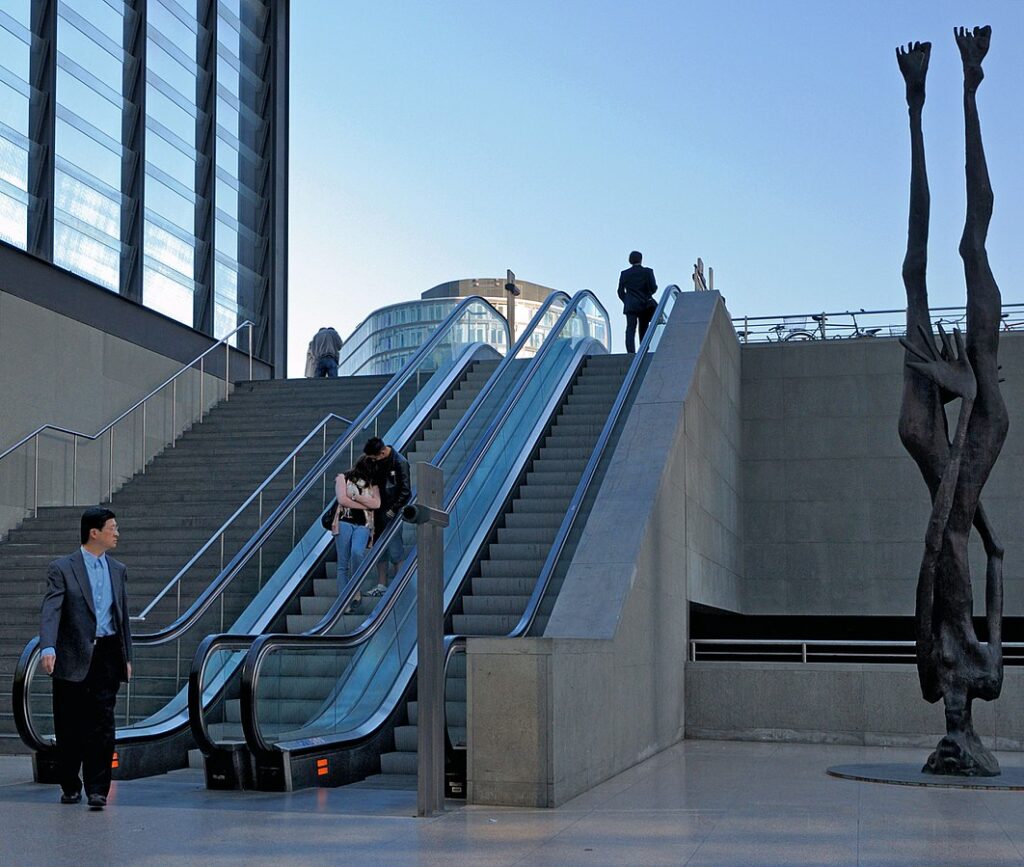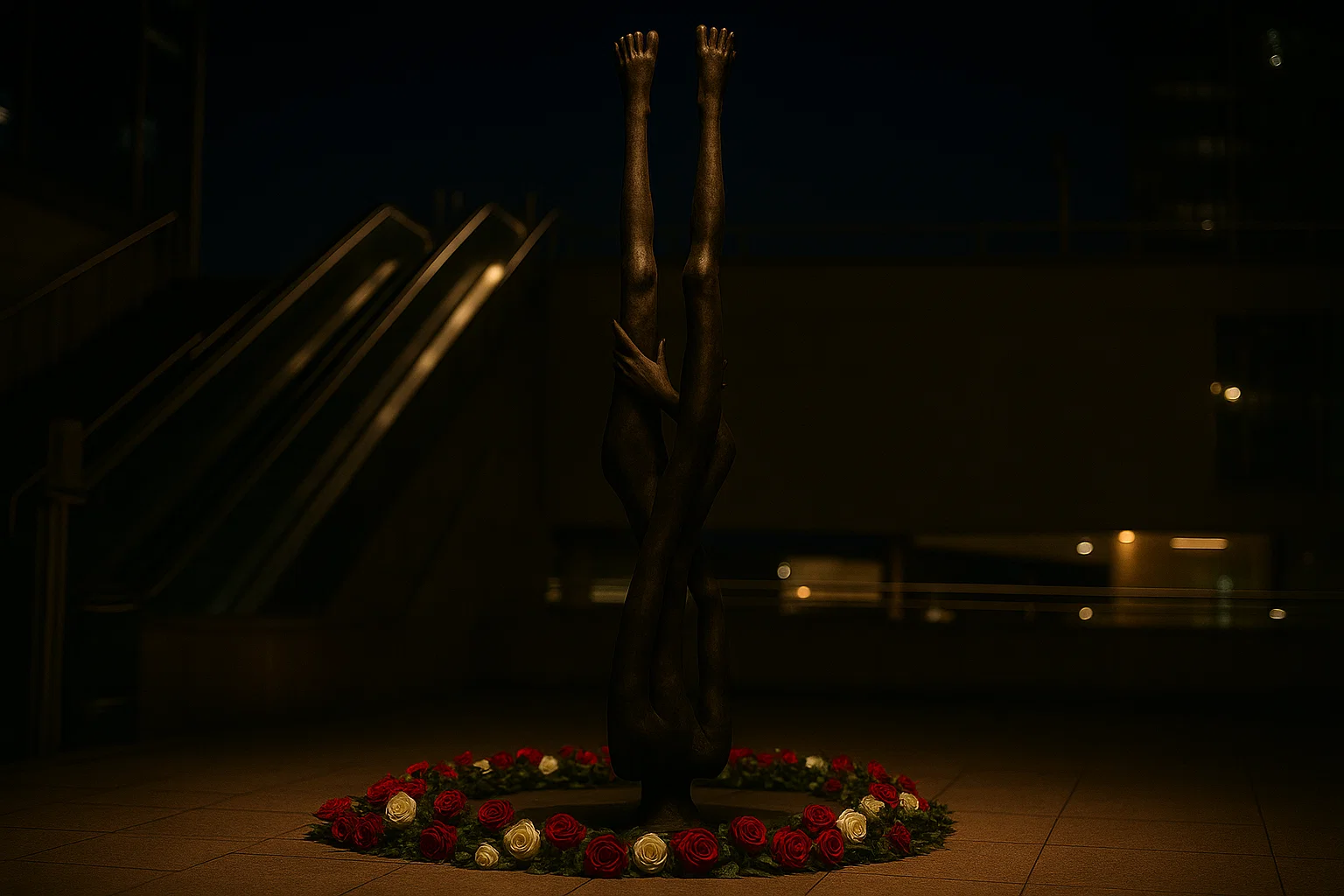Under the pale gaze of the moon, in the midst of a city whose heart once pulsed with the secrets of Europe, the statue rises, not with the grandeur of the upright, but suspended, head towards earth, body entwined as if the chthonic fires had shaped every muscle and sinew. The place where the statue stands recalls layers of silence; Potsdamer Platz, a locus traversed by the tides of war, renewal, and forgetfulness. Between slabs of cold concrete and the glass skin of buildings whose geometry repels memory, stands the sign. It is a form inverted, a flame contained, an echo of something older than the city and yet still breathing in its cracks.
Berlin opens here like a wound in stone, exposing strata where souls drift in the aftercurrents of devastation. The moonlight lingers, drawing contours not only on steel and glass but on the forms that pass by, pausing, seldom lingering long enough to see. In this threshold, the inverted figure gathers meaning; the body twisted an ongoing rite, an invitation to that which endures beneath the gaze of the living and the absence of the forgotten.
I. Inversion, Offering, and the Geometry of Flame
The sculpted form does not ascend; it descends, inviting contemplation into the depths where fire does not only destroy, it transmutes. Each limb, turned skyward, resembles the branches of a tree struck by lightning, each sinew a line etched by the memory of burning. The statue becomes a vessel; in the hollow of the inverted body, the city’s nocturnal currents gather, swirling like incense in the chambers of an unseen temple. The body, neither resting nor resisting, reveals the shape of the wound made visible, the hermetic container where agony becomes aperture. In the hidden language of the elements, the head points toward the earth, feet stretch towards constellations; the axis of the body crosses worlds, speaking of the union of above and below, spirit and matter, moonlight and ash.
Sometimes, tiny rituals unfold, sometimes witnessed, more often unseen: small offerings appear, nuts or grains placed at the four directions, gestures that mark the square as sacred, the centre as alive, the chora restored. This geometry is never arbitrary; the offerings follow the pulse of the heavens, a lunar calendar unmarked by the clocks of commerce, inscribed instead in the breath and stillness of those who carry memory in their hands. The fire that once consumed the thinker flickers within the figure; the agony does not cry for vengeance, it radiates a strange sweetness, a subtle intoxication that lingers in the air, summoning those who remember that the city’s heart, though ravaged, holds the seed of vision.
II. The Wounded Square and the Nocturnal Procession of Souls
In Potsdamer Platz, the night reveals the city’s secret anatomy. Buildings stand as angular guardians; within their shadows, the silence grows thick, gathering the unspoken prayers of those who once crossed this place. The destruction wrought by war left not only ruins, but a space marked by the loss of centre, the exile of the soul from its garden. But, amidst the reconstructed façades and indifferent footfalls, there gathers a current that remains unbroken, a procession of invisible forms that brush the skin and stir the hair, lingering at the edges of sight.
The statue, held upside-down, becomes a beacon to these wandering presences; its posture is secretly welcoming, the twisted limbs forming a gate through which the lunar mysteries circulate. The coldness of the architecture, the absence of ornament, the geometry stripped of memory, they all cannot erase the imprint of those who move between the worlds. At night, when the moon rides high, the air thickens with a pressure known only to those who have stood open; the boundary grows porous, the breath of the unseen mingles with the breath of the living.

Offerings given at the statue’s base awaken the memory of older rites: a city once beloved of gods, a crossroads where pilgrims, exiles, and visionaries converged. The square becomes again an antechamber, its emptiness a prelude, its silence a cup awaiting the next pour. In the hush that follows destruction, the souls of the forgotten gather, and the Rose roots herself, unseen, in the interstice between stone and shadow. The rituals – humble, hidden, lunar – mark the refusal of oblivion; each gesture, each trace, draws down the tides of memory, restoring to the city’s wound a measure of healing.
III. Bruno’s Fire and the Alchemy of the Daimon
The figure inverted is more than a mute vessel; it becomes the axis upon which the drama of modern memory revolves. History gathers in a single gesture, an Italian philosopher crossing borders, hunted by the zeal of empires, carrying within him the seed of a cosmos without centre or limit. Bruno entered the cities of Europe as the herald of a world emancipated from dogma, his vision shaped by the moonlit corridors of the Hermetic tradition, the labyrinths of Alexandria and the scrolls of forgotten sages. The flame that consumed him in Rome did not arise from error, but from a challenge hurled at the heart of power; in a world whose laws circled the same dying sun, he announced an infinite sky, stars innumerable, worlds teeming with life, the soul sovereign in its journey through the heavens.
His crime was abundance, his thought too wide for any one doctrine to contain, a language in which magic and science, Love and inquiry, mingled with the waters of Sophia. The agony made visible in bronze is the agony of a mind refusing confinement; each twisted limb recalls the forced silencing of visionaries, the centuries of books burnt and voices stifled. The inverted body reveals the secret current beneath history: each epoch attempts to cage the flame, yet the fire migrates, undimmed, to new hands. Bruno, martyr of the infinite, stands at the crossroads of philosophy, mysticism, and revolt; his memory irradiates every mind that dares to think beyond the circle, every soul that trembles before the true abyss of possibility. The square becomes a living manuscript; the city a palimpsest bearing the trace of those who refused to bow. The hidden Rose listens for the voice that still whispers: no boundary holds the light, no doctrine circumscribes the path of the soul, no death seals the word once uttered in truth.
Conclusion: The Flower Persists in the Lunar Night
In the nocturnal silence of Potsdamer Platz, where history compresses centuries of violence and renewal, the statue remains a beacon to the unfettered, a wound in the world’s memory, a promise that no darkness is absolute. Bruno’s flame, kindled in secret chambers and extinguished on public pyres, arcs through the ages, illuminating the paths of those who seek the risk of the Real. From the Inquisition’s shadow to the shattered heart of Berlin, his fire ignites new revolutions of thought, of Spirit, of Love that endures exile. The martyr’s agony is not an end, but a perpetual threshold, a portal through which every seeker, every rebel, every devotee of the infinite must pass.
The city forgets, the world rebuilds, yet the presence of Bruno, lunar and unvanquished, persists at the edge of vision, a burning mirror to those who dare to remember. The flower persists in the ruins; Her flame renews the vow. In every epoch, the question is asked anew: who will bear the fire, who will open the gate, who will utter the word no law can kill? The answer endures in the embers, in the wound, in the turning of the night towards dawn.
Post Scriptum: The Offering in the Lunar Veil
Whoever crosses the ground beneath the inverted flame, at the edge of the city’s restless arteries, may pause in quiet acknowledgment of the current that persists beneath stone and traffic. A gesture is enough: a kernel, a token, a remnant of earth, left in the shadow of the bronze, offered to the silent constellation that gathers where memory and fire intertwine. The Rose registers each act, folding it into the hidden ledger of those who still respond to the pulse of the sacred amidst ruin.
This place, once shattered and made strange by war and forgetting, becomes again an antechamber, a site of transmission for those who sense that the ordeal of the Spirit is never concluded, that the flame of Bruno seeks new vessels with each passage. To approach with reverence is to let the body receive the residue of his tribulation, to allow the inner fibre to be marked, however subtly, by the radiance that remains long after the pyre is cold. In this ritual, one that is simple, unspectacular, shielded from the gaze of distraction, the one who gives also receives; carrying forth a measure of his fire, veiled and enduring.
